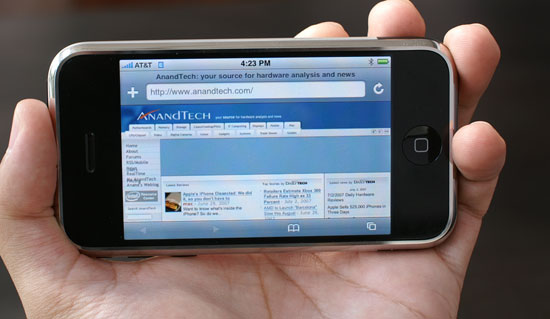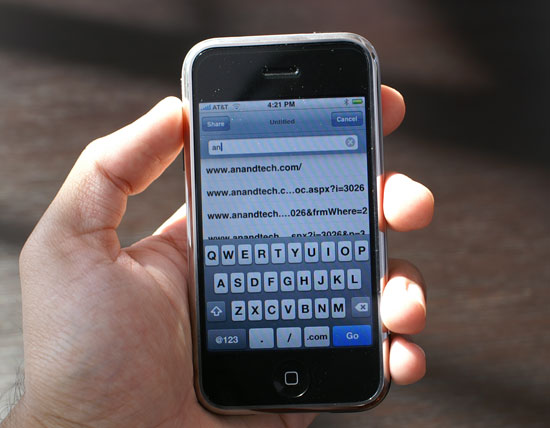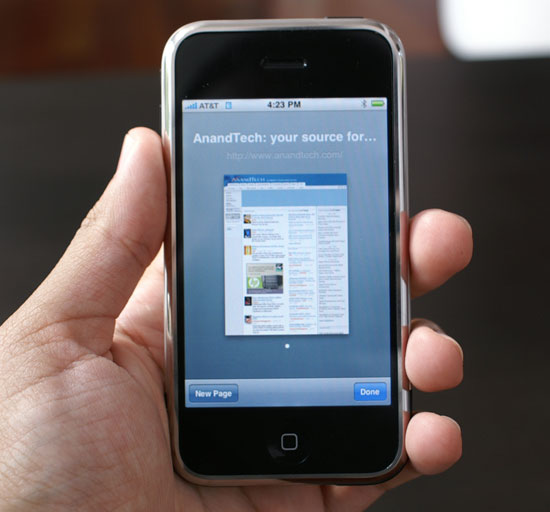Apple's iPhone: The Future is Here
by Anand Lal Shimpi on July 2, 2007 6:13 PM EST- Posted in
- Smartphones
- Mobile
Safari
The iPhone has four major functions, all of which are lined up along the bottom of the home screen. You've heard the keynote by now, it's a phone, it's an email client, it's an iPod and its a web browser. The iPhone ships with a port of Safari 3, and does actually make web surfing bearable on a mobile phone.
The problem with web surfing on most mobile phones is that the screens are so small that there's no reasonable way to display an entire web page. The manufacturers make a tradeoff and attempt to display the page at full resolution, forcing you to scroll around to find what you want. Site owners, in turn, create mobile-friendly versions of their websites that are basically long pages of text so you can at least read the content on a crippled browser.
By doing away with any sort of fixed input device, Apple freed up a lot of real estate on the iPhone for a huge screen. So why not try to display an entire website, just scaled down on this gorgeous screen? That's exactly what the iPhone does.
You get a zoomed out version of the same website you'd see on your computer, and using the same double tap/stretch/pinch gestures you can zoom in and navigate around the website. Double tapping can sometimes get annoying in Safari, if you accidentally double tap on a link, which is where the stretch gesture is useful. When you zoom in on a page the actual zooming process is quick, but there's about a one second delay before the website is usable again as the page is re-rendered in the new resolution. During this delay, nothing works, gestures, scrolling, clicking, etc... It's frustrating because the rest of the UI is so fast and responsive that whenever it stops it's even more pronounced.
Page rendering is also an issue; while a web page is loading you basically can't do anything else on the screen. For example, trying to scroll while a page is loading will either result in you not being able to scroll, or a choppy half scroll that stops abruptly. You're far better off waiting for the page to load before trying to proceed. Even trying to hit the X button to stop loading a page can take some time to process.

Expect to see this screen a lot
The problem is that even over WiFi (and especially over Edge), web pages can take a long time to fully render, and when the rest of the OS runs so smoothly it's frustrating to be in any situation where it doesn't. Just because you're on WiFi you shouldn't expect to get notebook-speed performance when loading web pages. My guess is that we're fairly CPU bound here, possibly compounded by a lack of system memory.

The vast majority of sites I visited had no problems with mini Safari 3 on the iPhone, although occasionally I'd run into a site that had issues with a background repeating itself too many times. There is no Flash or Java support, so expect to see many missing elements on websites (but on the bright side, it's like free ad-block right?).

AnandTech in my palm
Entering in URLs is very easy, you get a slightly different virtual keyboard in Safari than you do in other apps on the iPhone. There's no spacebar, but you have dedicated / and .com keys. There's no www. key but for most URLs you can just leave that part off and you'll be ok. Typing .net, .org or any other non-com TLDs can be frustrating since you don't have a one touch way of getting to those, but luckily Safari keeps a great history of previously visited URLs. Just typing "ana" in the address bar brings up AnandTech and a couple articles I visited while testing the iPhone.

One annoyance is that there's no quick way to bring up the address bar while on a web page; you have to scroll up to the top of the page to find the address bar, which can be a problem once again if the page isn't done rendering, making scrolling a little tough. Update: Thanks to a number of AnandTech readers, I now know a work-around for my Safari quirk. If you're at the bottom of a page in Safari, where the address bar isn't visible, simply tapping the top of the screen (where the time is) will take you to the top revealing, you guessed it, the address bar. Thanks to all who commented/wrote in, you've made my iPhone experience a little better :)
Multi-window browsing is supported on the iPhone, simply tap the icon in the lower right hand corner and select New Window to open a new browser window. You can also flip through open browser windows in this view, but once you open a couple windows the contents of the inactive ones are dumped from memory and simply reloaded when you switch back. Apple clearly made the iPhone as conservative as possible with its memory management.

Given that there is no copy/paste support, the only way to share something interesting with your friends/family/co-workers is to email them the URL. If you click on the address bar there's an option to "Share" the URL, which opens up an email window with the active URL pasted into the message body.
Safari on the iPhone is good, easily the best mobile browsing experience on any device this size and light years better than its closest competitors, but it needs work. I suspect that many of the problems will simply take software optimization and faster hardware to correct, but they are solvable and this is a step in the right direction.










85 Comments
View All Comments
rcc - Tuesday, July 3, 2007 - link
If there is no GPS hardware built into a device, 3rd party software won't help. You have to have the hardware receiver built in.
Locutus465 - Wednesday, July 4, 2007 - link
Fortunetly by law every new phone activated as of 2005 must have built in GPS for E-911.. Just one small baby step from there repurposes that GPS for coolness... My i720 allows this.strikeback03 - Thursday, July 5, 2007 - link
Doesn't the law simply require the carrier to be able to determine the location of the phone, but not specify how? Allowing the carriers to determine by distance to cell towers instead of GPS?Locutus465 - Thursday, July 5, 2007 - link
I beleive GPS is required... At least this is what I was told by a Verizon rep that refused to activate an older phone I had.Cygni - Thursday, July 5, 2007 - link
GPS is not required by law, yet. Location support IS required, but is already present on nearly every phone made in the last 3 years.plinden - Tuesday, July 3, 2007 - link
Leo Laporte in one of his podcasts this weekend mentioned that he heard there is an SDK for the iPhone that's ready for OS X but not Windows, but Apple (ie Jobs) wants to release both versions at the same time, hence the delay.
That's just a rumor, but it's almost certain there'll be an SDK at some point, although it's extremely likely, if not certain, that developers will have to go through Apple to get their apps published to the iPhone (ie via iTunes).
Give it six months, like I'm doing. I'll likely get the 16GB version with 3G when it's available.
Locutus465 - Tuesday, July 3, 2007 - link
There will need to be good 3rd party support for me to even consider it. There'll also need to be a good (and inexpensive) all in one chat client. And Mahjoong, that's totally a requirement.sviola - Tuesday, July 3, 2007 - link
You should check the Nokia N95, it has the built-in GPS, altough it runs Symbian OS.Locutus465 - Tuesday, July 3, 2007 - link
Well yes, my phone has built in GPS hardware as well (as do all phone inc. iPhone). It's just missing the app + maps (unless you're sayind the nokia comes with software + maps which would be the bomb). So I would just need that part of the equation. As a matter of fact the Samsung i720 also allows you to use the phone as a plain old GPS device, so really if I wanted to I could potentially blue tooth it to a laptop for instance and go that route.Locutus465 - Tuesday, July 3, 2007 - link
Oh yeah, on the i720 to set an MP3 as your ring tone you just need to browse to it in flie explorer, tap and hold ("right click" in Windows Mobile) and select "Set as ringtone" :)Automatically copies to \Windows\Rings and sets the song as your ringtone :D